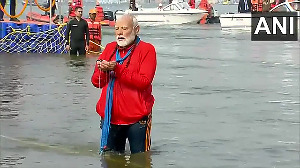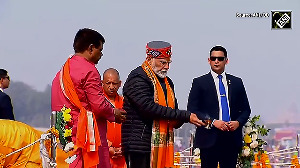
Part I: India's arms bill: Rs 32,000 crore-plus
Costly imports will continue to help India maintain both conventional and nuclear deterrence even though the price negotiation committee of the ministry of defence has found several deals too steep and the all-party standing committee on defence has urged the floating of global tenders in the interests of competitive pricing.
The two principal sticking points are a $750 million -- Rs 3,427.5 crore (Rs 34.275 billion) at a conversion rate of Rs 45.7/$ -- deal for a crippled Soviet aircraft carrier and an artillery system for the Arjun main battle tank.
The Russians are reportedly predicating the leasing of two nuclear-powered submarines on an approximately $750 million deal for a Soviet aircraft carrier, Admiral Gorshkov, that was crippled by a fire and has been lying unused for over a decade.
Admiral Gorshkov is being offered for the price of its refit. The cost of leasing the two nuclear-powered submarines is not known.
Russia is also insistent that India buy around 40 MiG 29 K (Fulcrum) interceptor/ground attack fighters for the carrier's air group for around $1.3 billion (Rs 5,941 crore).
Price negotiations for Admiral Gorshkov and the "associated" lease of the two nuclear-powered submarines are nearing closure, despite the all-party standing committee urging the defence ministry to reduce its reliance on Russia for military equipment and asking it to float global tenders to enable the "emergence of competitive prices."
The ministry, however, told the committee that its dependence on Russia for new equipment, upgrades, spares and ammunition would continue.
It said Russia had proven itself a dependable ally in times of need, like the 1999 summer war with Pakistan and when sanctions were imposed on India after its 1998 nuclear tests.
Three Navy teams have visited Russia since 1995 to examine the feasibility of acquiring the Gorshkov and have recommended that the carrier is capable of remaining in operational service for 20 years following a refit.
And though India finds the price being demanded for the carrier's refit unacceptable, the final investment decision will be taken following the recommendation of a newly constituted committee in the defence ministry.
In an interview to UK's Jane's Defense Weekly earlier this year, Navy chief Admiral Madhavendra Singh said the MiG 29 K, with "better capability to strike further afield" was definitely in the reckoning to form the Gorshkov's air group as well as that of the air defence ship being built locally, as "limited choices" were available.
The Navy also recently commissioned INS Talwar and INS Trishul, two Russian Project 1135.6 frigates, while INS Tabar, the third and last vessel in the $1 billion (Rs 4570 crore) deal, is scheduled to enter service by the end of this year.
In his Jane's interview Admiral Singh hinted that the Navy might go in for additional Russian-built Talwar-class frigates as local shipyards were incapable of meeting its demands to sustain force levels.
Also, a deal with France for over $700 million (Rs 3,199 crore) to locally build six Scorpene submarines might be signed by the end of the current financial year, officials said.
Meanwhile, the Army's artillery modernisation programme could be stalled following serious differences over the cost of the Bhim, produced by mating South African firm Denel Ordnance's LIW T 6 155mm/ 52 cal turret system with the chassis of the locally designed Arjun main battle tank.
Official sources said Denel was reportedly demanding between $3.2 million (Rs 14.62 crore) and $3.5 million (Rs 15.99 crore) per turret, an amount the defence ministry's price negotiation committee was unwilling to pay to complete Bhim, a self-propelled (SP) howitzer system of which India initially wants between 100 and 120 with the remaining 400-450 to be built locally to equip around 30 mechanised infantry regiments.
Armament industry sources said this pricing excluded the land navigation and fire control systems and integration costs, estimated to cost a further $1 million (Rs 4.57 crore).
Denel has tied up locally with Bharat Earth Movers Ltd in Bangalore to fabricate the Bhim.
They said that with the Arjun chassis -- powered by the German MTU 838 Ka-510, 1400 hp diesel engine priced between $3.12 million (Rs 14.25 crore) and $3.54 million (Rs 16.17 crore) each -- the Bhim would eventually cost $7.32 million (Rs 33.45 crore) to $8.04 million (Rs 36.74 crore) per piece.
MTU nearly doubled the cost of its engines two years ago to around $1.1 million (Rs 5.02 crore), substantially raising Arjun's price, sources said.
India bought 40-50 MTU engines in the late 1990s and reportedly ordered a fresh batch last year, confirming India position among the world's largest buyers of military equipment.
Overall, the artillery modernisation programme -- which includes a combination of towed and wheeled howitzers in addition to the Bhim -- is expected to cost over $18.75 billion (Rs 85,687.50 crore) over the next two decades.
Meanwhile, the Army has just concluded firing trials involving three 155mm towed artillery systems in Pokhran.
Soltam Systems of Israel, Denel Ordnance and SWS Defence AB of Sweden are competing for the order for around 400 howitzers that India requires as part of its field artillery rationalisation plan.
Last year all three vendors underwent technical and field evaluations at the artillery centre and school at Deolali and at Pokhran, respectively, of their wheeled, self-propelled howitzers, but no orders have been forthcoming.






 © 2025
© 2025